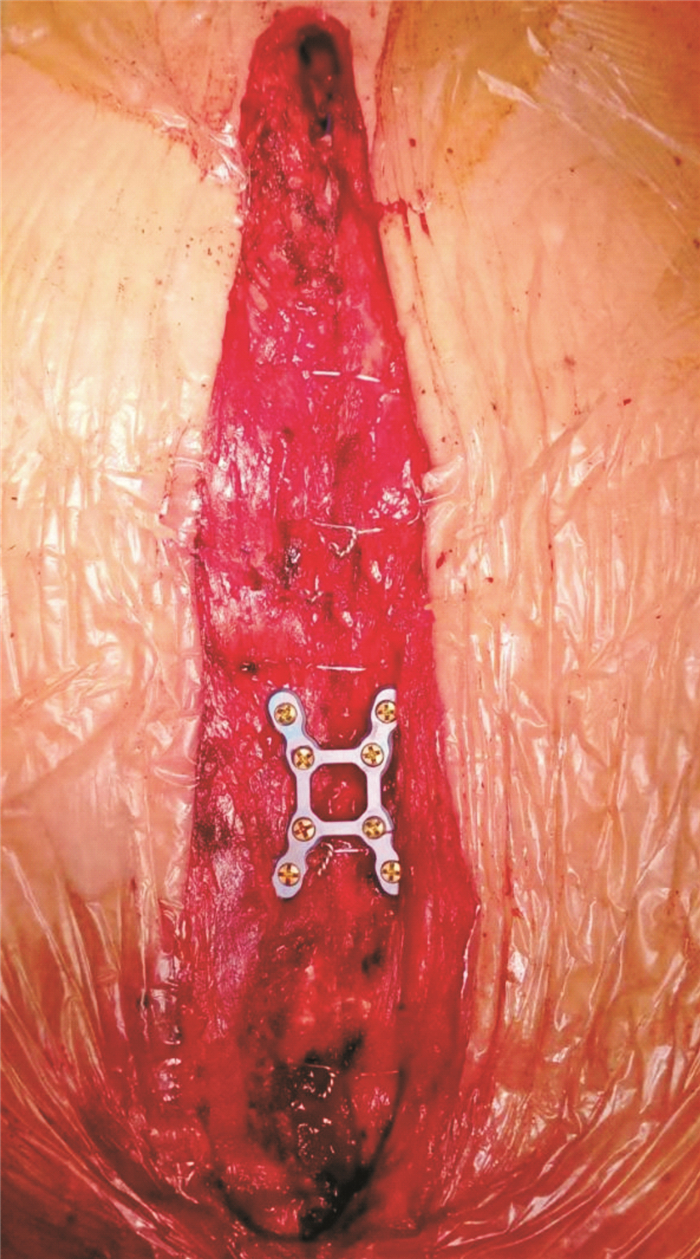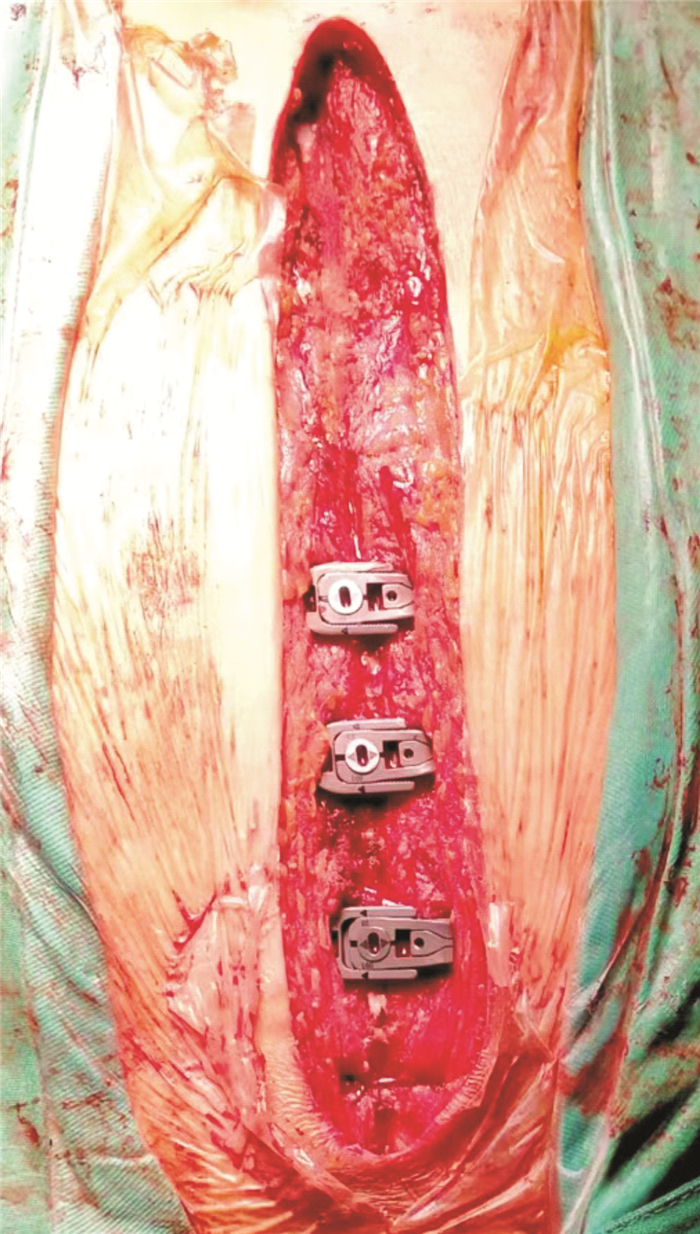Application of different sternal fixation models in cardiac surgery for high-risk patients with sternal dehiscence
-
摘要: 目的 探讨应用钢丝、钛板和胸骨板3种胸骨固定模式在胸骨哆开高危患者心脏手术中的治疗效果和影响因素。方法 回顾性收集2019年1月—2021年12月连续就诊于郑州大学第一附属医院行正中开胸心脏手术的615例胸骨哆开高危患者的临床资料,其中198例行单纯钢丝环扎术固定胸骨为钢丝组,203例应用钢丝联合钛板固定胸骨为钛板组,214例应用钢丝联合胸骨板固定胸骨为胸骨板组。对比3组围手术期指标、术后胸骨感染、哆开及再次固定情况,采用单因素和多因素logistic回归分析探讨影响胸骨哆开的危险因素。结果 与钢丝组比较,钛板组及胸骨板组关胸时间显著延长,各组间比较差异均有统计学意义(P < 0.05)。与钢丝组比较,钛板组及胸骨板组术后24 h引流量、重症监护时间、机械通气时间及术后住院天数均减少,且3组间差异有统计学意义(P < 0.001)。术后切口发生感染、胸骨哆开和胸骨再固定情况,钢丝组发生率均高于钛板组和胸骨板组,胸骨板组发生率最低,差异均有统计学意义(P < 0.05)。logistic多因素回归分析显示,年龄(OR=1.119,95%CI:1.047~1.196,P=0.001)、吸烟(OR=16.865,95%CI:4.994~56.960,P < 0.001)、慢性阻塞性肺疾病(COPD)(OR=4.140,95%CI:1.556~11.014,P=0.004)、肾功能不全(OR=3.952,95%CI:1.236~12.636,P=0.020)、长期使用激素(OR=13.894,95%CI:2.314~83.402,P=0.004)是术后发生胸骨哆开的独立危险因素。结论 年龄、吸烟、COPD、肾功能不全及长期使用激素是高危患者术后发生胸骨哆开的独立危险因素。在正中开胸心脏手术后应用钢丝联合钛板或钢丝联合胸骨板固定胸骨均可减少术后发生胸骨哆开,钢丝联合胸骨板固定胸骨临床效果最好,可加强高危患者心脏外科术后胸骨固定的稳定性,值得推广。Abstract: Objective To explore the treatment effect of wire cerclage, titanium plate fixation, and sternal plate fixation in the cardiac surgery of high-risk patients with sternal dehiscence and summarize the application experience.Methods A retrospective analysis was performed on 615 high-risk patients with sternal dehiscence who underwent surgical treatment in the Department of Cardiovascular Surgery, The First Affiliated Hospital of Zhengzhou University from January 2019 to December 2021, 198 cases who underwent traditional steel wires were included in steel wire group, 203 cases who received wire and titanium plate fixation were selected as titanium plate group and 214 cases receiving wire and sternal plate fixation were set as sternal plate group. The perioperative indicators, sternal infection, sternal dehiscence and sternal refixation were compared among the three groups. Univariate and multivariate logistic regression analysis were used to investigate the risk factors of sternal dehiscence in high-risk patients undergoing cardiac surgery.Results Compared with the steel wire group, the chest closure time of the titanium plate group and sternal plate group were significantly prolonged, there were significant differences among the groups(P < 0.05). Compared with the steel wire group, the drainage at 24 h after surgery, length of stay in the intensive care unit, duration of mechanical ventilation and hospital stay after cardiovascular surgery in titanium plate group and sternal plate group were less, and there were significant differences among the three groups(P < 0.001). The number of the postoperative incision infection, sternal dehiscence, and sternal refixation were lower in the titanium plate group and sternal plate group than that in the steel wire group, the incidence of the sternal plate group was the lowest, with statistically significant differences(P < 0.05). Multivariate regression analysis showed that age(OR=1.119, 95%CI: 1.047-1.196, P=0.001), smoking(OR=16.865, 95%CI: 4.994-56.960, P < 0.001), chronic obstructive pulmonary disease(COPD)(OR=4.140, 95%CI: 1.556-11.014, P=0.004), renal failure(OR=3.952, 95%CI: 1.236-12.636, P=0.020) and long-term use of hormones(OR=13.894, 95%CI: 2.314-83.402, P=0.004) were independent risk factors for sternal dehiscence after cardiac surgery.Conclusion Age, smoking, COPD, renal failure, and long-term use of hormones are independent risk factors for sternal dehiscence in high-risk patients after cardiac surgery. The application of wire combined with the titanium plate and wire combined with sternal plate can reduce the risk of sternal dehiscence and sternal refixation, wire and sternal plate fixation has the best treatment effect, which enhances the stability of sternal fixation in high-risk patients after cardiac surgery. It is worthy of clinical promotion and popularization.
-

-
表 1 患者术前基线资料
Table 1. Baseline clinicial characteristics
例(%), X±S 项目 钢丝组(198例) 钛板组(203例) 胸骨板组(214例) F/χ2值 P值 年龄/岁 62.38±7.18 61.43±7.01 62.20±7.14 1.019 0.362 男性 107(54.0) 112(55.2) 116(54.2) 0.061 0.970 BMI 25.52±3.54 25.18±4.28 25.29±4.07 0.379 0.684 吸烟 74(37.4) 69(34.0) 81(37.9) 0.784 0.676 糖尿病 158(79.8) 155(76.4) 161(75.2) 1.301 0.522 高血压 154(77.8) 159(78.3) 162(75.7) 0.457 0.796 COPD 54(27.3) 60(29.6) 62(29.0) 0.276 0.871 肾功能不全 24(12.1) 23(11.3) 28(13.1) 0.301 0.860 长期使用激素 6(3.0) 7(3.4) 5(2.3) 0.464 0.793 二次开胸 7(3.5) 10(4.9) 9(4.2) 0.479 0.787 LVEF/% 55.89±5.63 55.61±6.86 55.07±6.11 0.939 0.391 心功能Ⅲ~Ⅳ级 125(63.1) 141(69.5) 144(67.3) 1.863 0.394 表 2 围手术期资料
Table 2. Perioperative data
例(%), X±S 项目 钢丝组(198例) 钛板组(203例) 胸骨板组(214例) F/χ2值 P值 关胸时间/min 20.20±1.16 28.05±3.30 23.29±2.28 538.48 < 0.001 CABG 109(55.1) 110(54.2) 106(49.5) 1.475 0.478 瓣膜置换术 54(27.3) 57(28.1) 62(29.0) 0.147 0.929 CABG/瓣膜置换术 23(11.6) 20(9.9) 27(12.6) 0.805 0.669 其他手术 12(6.1) 16(7.9) 19(8.9) 1.182 0.554 体外循环时间 > 2 h 33(16.7) 40(19.7) 38(17.8) 0.644 0.725 术后24 h引流量/mL 412.02±135.65 372.98±138.43 358.53±116.45 9.18 < 0.001 重症监护时间/h 36.28±2.54 33.39±1.48 32.53±1.66 207.74 < 0.001 机械通气时间/h 16.88±1.08 15.33±1.63 14.34±2.04 123.903 < 0.001 术后住院天数/d 8.04±0.92 7.01±0.63 6.87±0.76 134.587 < 0.001 开胸止血 15(7.6) 12(5.9) 9(4.2) 2.121 0.346 新发心房颤动 64(32.3) 72(35.5) 79(36.9) 0.989 0.610 IABP 15(7.6) 19(9.4) 21(9.8) 0.697 0.706 CABG:冠状动脉旁路移植术。 表 3 术后并发症的比较
Table 3. Comparison of postoperative complications
例(%) 项目 钢丝组(198例) 钛板组(203例) 胸骨板组(214例) F/χ2值 P值 胸骨哆开 16(8.1) 7(3.4) 4(1.9) 10.094 0.006 胸骨切口深部感染 21(10.6) 10(4.9) 9(4.2) 8.169 0.017 胸骨切口表面感染 34(17.2) 23(4.9) 17(7.9) 18.255 < 0.001 胸骨再次固定 11(5.6) 4(2.0) 2(0.9) 8.881 0.012 表 4 高危患者术后胸骨哆开的单因素回归分析
Table 4. Univariate regression analysis of sternal dehiscence in high-risk patients after cardiac surgery
影响因素 β SE Wald OR 95% CI P值 年龄 0.115 0.030 14.986 1.122 1.059~1.190 < 0.001 男性 0.156 0.394 0.156 1.169 0.540~2.529 0.692 BMI -0.050 0.053 0.907 0.951 0.858~1.055 0.341 吸烟 1.900 0.471 16.280 6.688 2.657~16.835 < 0.001 糖尿病 -0.498 0.420 1.410 0.608 0.267~1.383 0.235 高血压 -0.317 0.433 0.537 0.728 0.312~1.700 0.464 COPD 1.032 0.396 6.796 2.808 1.292~6.102 0.009 肾功能不全 0.936 0.457 4.190 2.549 1.041~6.242 0.041 长期使用激素 1.792 0.678 6.978 6.000 1.588~22.673 0.008 二次开胸 1.216 0.651 3.487 3.375 0.941~12.100 0.062 手术 CABG 1.000 瓣膜置换术 0.012 0.479 0.001 1.012 0.396~2.585 0.980 CABG/瓣膜置换术 0.375 0.588 0.407 1.455 0.460~4.601 0.524 其他手术 0.492 0.660 0.556 1.636 0.448~5.971 0.456 关胸方式 钢丝 1.000 钛板 -0.901 0.465 3.757 0.406 0.163~1.010 0.043 胸骨板 -1.529 0.568 7.247 0.217 0.071~0.660 0.007 体外循环 > 2 h 0.488 0.452 1.164 1.629 0.671~3.952 0.281 新发心房颤动 0.094 0.408 0.054 1.099 0.494~2.444 0.817 LVEF 0.055 0.037 2.183 1.057 0.982~1.137 0.140 心功能分级 -0.650 0.395 2.705 0.522 0.241~1.133 0.100 术后24 h引流量 0.003 0.001 5.288 1.003 1.000~1.006 0.021 重症监护时间 0.184 0.083 4.936 1.203 1.022~1.415 0.026 机械通气时间 0.200 0.100 3.999 1.221 1.004~1.485 0.046 术后住院时间 0.435 0.207 4.408 1.545 1.029~2.318 0.036 IABP 0.605 0.561 1.162 1.831 0.610~5.501 0.281 开胸止血 1.073 0.571 3.538 2.925 0.956~8.950 0.060 关胸时间 -0.036 0.052 0.492 0.964 0.871~1.067 0.483 表 5 高危患者术后胸骨哆开的多因素回归分析
Table 5. Multivariate regression analysis of sternal dehiscence in high-risk patients after cardiac surgery
影响因素 β SE Wald OR 95% CI P值 年龄/岁 0.112 0.034 10.889 1.119 1.047~1.196 0.001 吸烟 2.825 0.621 20.699 16.865 4.994~56.960 < 0.001 COPD 1.421 0.499 8.096 4.140 1.556~11.014 0.004 肾功能不全 1.374 0.593 5.372 3.952 1.236~12.636 0.020 长期使用激素 2.631 0.914 8.281 13.894 2.314~83.402 0.004 术后24 h引流量 0.003 0.002 3.827 1.003 1.000~1.006 0.050 重症监护时间 0.157 0.100 2.486 1.171 0.962~1.424 0.115 机械通气时间 0.093 0.179 0.274 1.098 0.774~1.558 0.601 术后住院时间 0.216 0.301 0.518 1.241 0.689~2.237 0.472 钢丝 1.000 钛板 -0.929 0.877 1.122 0.395 0.071~2.202 0.289 胸骨板 -0.263 0.705 0.139 0.769 0.193~3.059 0.709 -
[1] Raman J, Straus D, Song DH. Rigid plate fixation of the sternum[J]. Ann Thorac Surg, 2007, 84(3): 1056-1058. doi: 10.1016/j.athoracsur.2006.11.045
[2] Allen KB, Thourani VH, Naka Y, et al. Randomized, multicenter trial comparing sternotomy closure with rigid plate fixation to wire cerclage[J]. J Thorac Cardiovasc Surg, 2017, 153(4): 888-896. e1. doi: 10.1016/j.jtcvs.2016.10.093
[3] Cataneo DC, Dos Reis TA, Felisberto G, et al. New sternal closure methods versus the standard closure method: systematic review and meta-analysis[J]. Interact Cardiovasc Thorac Surg, 2019, 28(3): 432-440. doi: 10.1093/icvts/ivy281
[4] Allen KB, Thourani VH, Naka Y, et al. Rigid plate fixation versus wire cerclage: patient-reported and economic outcomes from a randomized trial[J]. Ann Thorac Surg, 2018, 105(5): 1344-1350. doi: 10.1016/j.athoracsur.2017.12.011
[5] Nenna A, Nappi F, Dougal J, et al. Sternal wound closure in the current era: the need of a tailored approach[J]. Gen Thorac Cardiovasc Surg, 2019, 67(11): 907-916. doi: 10.1007/s11748-019-01204-5
[6] De Cicco G, Tosi D, Crisci R, et al. Use of new cannulated screws for primary sternal closure in high risk patients for sternal dehiscence[J]. J Thorac Dis, 2019, 11(11): 4538-4543. doi: 10.21037/jtd.2019.10.79
[7] CDC definitions for nosocomial infections[J]. Am J Infect Control, 1989, 17(1): 42-43.
[8] Park JS, Kuo JH, Young JN, et al. Rigid sternal fixation versus modified wire technique for poststernotomy closures: a retrospective cost analysis[J]. Ann Plast Surg, 2017, 78(5): 537-542. doi: 10.1097/SAP.0000000000000901
[9] Ali U, Bibo L, Pierre M, et al. Deep sternal wound infections after cardiac surgery: a new Australian tertiary centre experience-sciencedirect[J]. Heart, Lung and Circulation, 2020, 29(10): 1571-1578. doi: 10.1016/j.hlc.2020.02.003
[10] Listewnik MJ, Jędrzejczak T, Majer K, et al. Complications in cardiac surgery: An analysis of factors contributing to sternal dehiscence in patients who underwent surgery between 2010 and 2014 and a comparison with the 1990-2009 cohort[J]. Adv Clin Exp Med, 2019, 28(7): 913-922. doi: 10.17219/acem/94154
[11] El Oakley RM, Wright JE. Postoperative mediastinitis: classification and management[J]. Ann Thorac Surg, 1996, 61(3): 1030-1036. doi: 10.1016/0003-4975(95)01035-1
[12] Tam DY, Nedadur R, Yu M, et al. Rigid plate fixation versus wire cerclage for sternotomy after cardiac surgery: A meta-analysis[J]. Ann Thorac Surg, 2018, 106(1): 298-304. doi: 10.1016/j.athoracsur.2018.02.043
[13] Madjarov JM, Katz MG, Fazal S, et al. Use of longitudinal rigid sternal fixation in prevention and treatment of wound complications among high-risk patients after cardiac surgery[J]. J Card Surg, 2021, 36(9): 3155-3162. doi: 10.1111/jocs.15687
[14] Royse AG, El-Ansary D, Hoang W, et al. A randomized trial comparing the effects of sternal band and plate fixation of the sternum with that of figure-of-8 wires on sternal edge motion and quality of recovery after cardiac surgery[J]. Interact Cardiovasc Thorac Surg, 2020, 30(6): 863-870. doi: 10.1093/icvts/ivaa040
[15] Allen KB, Icke KJ, Thourani VH, et al. Sternotomy closure using rigid plate fixation: a paradigm shift from wire cerclage[J]. Ann Cardiothorac Surg, 2018, 7(5): 611-620. doi: 10.21037/acs.2018.06.01
[16] Park JS, Kuo JH, Young JN, et al. Rigid sternal fixation versus modified wire technique for poststernotomy closures: A retrospective cost analysis[J]. Ann Plast Surg, 2017, 78(5): 537-542. doi: 10.1097/SAP.0000000000000901
[17] Kaspersen AE, Nielsen SJ, Orrason AW, et al. Short-and long-term mortality after deep sternal wound infection following cardiac surgery: experiences from SWEDEHEART[J]. Eur J Cardiothorac Surg, 2021, 60(2): 233-241. doi: 10.1093/ejcts/ezab080
[18] Nooh E, Griesbach C, Rösch J, et al. Development of a new sternal dehiscence prediction scale for decision making in sternal closure techniques after cardiac surgery[J]. J Cardiothorac Surg, 2021, 16(1): 174. doi: 10.1186/s13019-021-01555-2
[19] 董柱, 曹一秋, 张本, 等. 人工瓣膜置换术后感染的危险因素分析及预防策略[J]. 临床心血管病杂志, 2019, 35(4): 300-305. https://www.cnki.com.cn/Article/CJFDTOTAL-LCXB201904003.htm
[20] 喻雪飞, 董柱, 张本, 等. 急性Stanford A型主动脉夹层术后感染的危险因素分析及预防策略[J]. 临床心血管病杂志, 2021, 37(8): 758-763. https://www.cnki.com.cn/Article/CJFDTOTAL-LCXB202108017.htm
[21] Biancari F, Gatti G, Rosato S, et al. Preoperative risk stratification of deep sternal wound infection after coronary surgery[J]. Infect Control Hosp Epidemiol, 2020, 41(4): 444-451. doi: 10.1017/ice.2019.375
[22] Starnes-Roubaud MJ, Chang EI. Discussion: impact of chronic steroid use on plastic surgery outcomes: Analysis of 94, 140 cases[J]. Plast Reconstr Surg, 2018, 142(5): 780e-781e. doi: 10.1097/PRS.0000000000004950
-





 下载:
下载:
